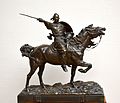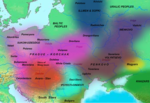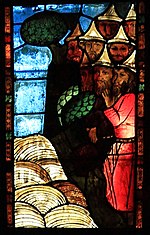Saltovo-Mayaki or Saltovo-Majaki is the name given by archaeologists to the early medieval culture of the Pontic steppe region roughly between the Don...
4 KB (383 words) - 04:09, 20 August 2024
Saltovo (‹See Tfd›Russian: Салтово) is a rural locality (a selo) and the administrative center of Saltovskoye Rural Settlement, Staropoltavsky District...
3 KB (105 words) - 13:06, 18 May 2023
place-name that can refer to: Golden Hills, California Golden Hills (Russia), a Saltovo-Mayaki archaeological site in southern Russia, near Rostov This disambiguation...
201 bytes (58 words) - 15:29, 28 December 2019
kultúrkör [Hungarian prehistory and the archaeological cultural circle of Saltovo] (PhD thesis) (in Hungarian). University of Szeged. doi:10.14232/phd.1167...
103 KB (10,476 words) - 20:29, 22 September 2024
culture Hongshan culture Čaatas culture Askiz culture Kurumchi culture Saltovo-Mayaki Saymaluu-Tash Bilär Por-Bazhyn Ordu-Baliq Jankent There are several...
199 KB (21,429 words) - 23:22, 29 September 2024
Sviatoslav's campaigns led to increased Slavic settlement in the region of the Saltovo-Mayaki culture, greatly changing the demographics and culture of the transitional...
42 KB (4,971 words) - 16:46, 17 September 2024
again Afanasiev et al. analyzed skeletons of various Sarmato-Alan and Saltovo-Mayaki culture Kurgan burials. The two Alan samples from the fourth to...
81 KB (8,705 words) - 05:11, 12 September 2024
Alans (category Saltovo-Mayaki culture)
of Archaeology in Moscow conducted research on various Sarmato-Alan and Saltovo-Mayaki culture Kurgan burials. In this analysis, the two Alan samples from...
63 KB (6,708 words) - 10:33, 23 September 2024
Khazars (category Saltovo-Mayaki culture)
steppe polities, the Khazar Qağanate developed a self-sufficient domestic Saltovo economy, a combination of traditional pastoralism – allowing sheep and...
218 KB (25,584 words) - 03:49, 5 October 2024
animal style dates back to Scythian art, having been prominent in the Saltovo-Mayaki culture. Schapov explains this by the fact that Vsevolod the Big...
10 KB (853 words) - 22:51, 20 July 2024
Researchers have noted the presence of a significant amount of artifacts of the Saltovo-Mayaki culture, associated with the Khazar Khaganate. The main marker of...
7 KB (874 words) - 15:51, 10 July 2024
Bulgars (category Saltovo-Mayaki culture)
the north of the town Karachayevsk, where the pottery belonged to the Saltovo-Mayaki culture. Kuznecov also found a connection in the plan of the Danube...
108 KB (11,949 words) - 22:06, 3 October 2024
Golden Hills Kaffa Kavkaz Kazarki Kerch Kerem Khazaran Khumar Levedia Saltovo-Mayaki Samandar Sambalut Sambat Samiran Samosdelka Saqsin Sarkel Semikarakorsk...
4 KB (464 words) - 22:21, 25 May 2024
Saltovo ware) also occurs in the Ukrainian Penkovka sites as well as in the lower Danube and Bulgaria, but is most commonly found within the Saltovo-Mayaki...
11 KB (1,426 words) - 23:35, 3 January 2024
populations. In the 8th to 10th centuries the Khazar fortress of Verkhneye Saltovo stood about 25 miles (40 km) east of the modern city, near Staryi Saltiv...
195 KB (15,982 words) - 12:13, 4 October 2024
Mayatskoye (category Saltovo-Mayaki culture)
Oblast, Russia.: 179 Along with Verkhnii Saltiv, it gives its name to the Saltovo-Mayaki culture, which is the main archaeological culture of the Khazars...
6 KB (474 words) - 13:41, 3 June 2024
condition of the monument. The relief is similar to the carbon images found in Saltovo, Soulek, Pliska and Veliki Preslav. The meaning and symbolism of the sculpture...
15 KB (1,451 words) - 11:23, 7 September 2024
and 10th centuries, it was a site of a fortified Khazar settlement of Saltovo-Mayaki culture. In the 18th and 19th centuries, the area attracted hermits...
74 KB (1,945 words) - 17:54, 17 September 2024
Atil (category Saltovo-Mayaki culture)
Atil, also Itil, was the capital of the Khazar Khaganate from the mid-8th century to the late 10th century. It is known historically to have been situated...
12 KB (1,373 words) - 18:10, 23 September 2024
Sviatoslav's campaigns led to increased Slavic settlement in the region of the Saltovo-Mayaki culture, greatly changing the demographics and culture of the transitional...
28 KB (3,263 words) - 01:56, 9 July 2024
Severians (category Saltovo-Mayaki culture)
built in forests or on elevations, around which villages developed. Some Saltovo-Mayaki forts were situated on Severian land. In the Primary Chronicle,...
13 KB (1,315 words) - 15:51, 10 July 2024
and Timișoara around 900. Cauldrons and further featuring items of the "Saltovo-Mayaki culture" of the Pontic steppes were unearthed in Alba Iulia, Cenad...
194 KB (24,005 words) - 01:43, 1 October 2024
Kushnarenkovo culture) from Cis-Ural and Trans-Ural region, and multiethnic "Saltovo-Mayaki culture" of the Pontic steppes. Most cemeteries from the 9th and...
113 KB (14,063 words) - 23:09, 28 September 2024
Hungarian prehistory (category Saltovo-Mayaki culture)
Archaeological finds show that the Khagans controlled a multi-ethnic empire. The "Saltovo-Mayaki culture", which flourished in the same region around 750 and 900...
90 KB (11,108 words) - 13:23, 4 September 2024
the Pontic–Caspian steppe). Moshchevaja Balka is considered part of the Saltovo-Mayaki archaeological culture. The caftan is associated with a pair of...
10 KB (1,275 words) - 04:18, 24 October 2023
from as early as 30,000 BC indicates the Saltovo-Mayaki were Antratsyt's earliest ancestors. Since the Saltovo-Mayaki were nomadic, the area was left uninhabited...
13 KB (1,278 words) - 06:15, 5 October 2024
Length 2000 Width 900 History Abandoned 1600s Periods Medieval Cultures Saltovo-Mayaki Satellite of Golden Horde Associated with Mongols Events Mongol...
8 KB (721 words) - 16:03, 18 September 2024
Sarkel (category Saltovo-Mayaki culture)
Sarkel (or Šarkel, literally "white house" in the Khazar language) was a large limestone-and-brick fortress in what is now Rostov Oblast of Russia, on...
9 KB (985 words) - 20:13, 18 July 2024
Khumar (category Saltovo-Mayaki culture)
inscriptions, an evidence of early medieval Turkic occupation by tribes of the Saltovo-Mayaki cultural group. Most of the inscriptions were heavily damaged by...
4 KB (421 words) - 08:43, 7 May 2022
Magomedov [ru] and Svetlana Pletnyova consider the eighth-century emergence of the Saltovo-Mayaki culture in the steppe region between the Don and Dnieper Rivers...
83 KB (11,673 words) - 13:20, 13 June 2024
























